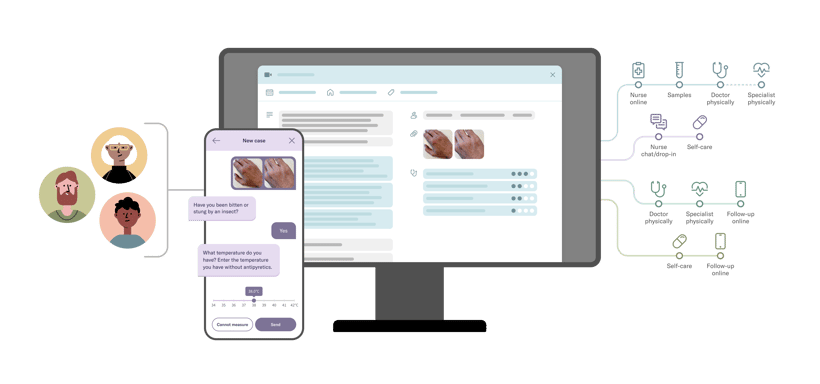Red Robin, Visiba Care’s tool for automated medical history collection and decision support will soon be available commercially for healthcare providers. The product has been tested intensively during 2019 and the beginning of 2020. During the last few months, two healthcare providers in Sweden enrolled Red Robin in two respective pilots in a real-life environment, with actual patient cases and practising healthcare professionals. These projects were illuminating for the future development of the product – in this post, we will outline the details of the pilots, the lessons learned, and the way towards the broader vision, where Red Robin is headed in the future.
As the COVID-19 pandemic started to spread around Sweden, healthcare providers responded promptly. It was during that phase and a couple of weeks apart from each other that we launched Red Robin in two separate pilot projects with two publicly-funded healthcare providers in Sweden. We had two main areas of focus:
- Patient side – to see statistically how the patients react, identify the most important areas for the best patient experience, and finally, get evidence on the most important functions for the patients in the most real-life setting possible (being actually sick and having to solve the flow without supervision in a fully digital flow).
- Healthcare professional side – to pinpoint the most valuable parts of the solution in the context of the current way of working, so that we can fuel further improvement and long-run development delivering value from step one.
Aside from the evident pressure on their resources amidst the pandemic, the healthcare providers we collaborated with had a motivation of their own: They have both reached a certain level of digital maturity with online consultations being recognised digital primary care providers in their regions with steady and growing patient inflow. So they wanted to take the next step and explore new technologies that have the potential to improve their service for patients and provide better tools for their healthcare professionals.
Practical set-up: Integrating Red Robin in the Visiba Care booking flow
Red Robin was incorporated as a seamless part of the regular booking flow for a selection of specific reasons for visit, e.g. skin problems, respiratory problems, sore throat etc. This allowed us to keep the same entry point for all patients as before, so in this respect, the regular patients recognised the initial steps before the booking and the overall flow could be analysed in the terms of “before/after” statistics. Taking it step by step, when patients entered the flow to book an online consultation, their first choice in the list of the reasons for visit defined if they were directed to Red Robin. For the selected reasons, an automated chat-based dialogue was initiated. Based on the patient’s initial description in free text and response to every next question, Red Robin adjusted the follow-up questions by narrowing down the most relevant areas in the background. The patients could take their time to answer these questions and at the end of the dialogue, they were directed to book a digital appointment with a relevant healthcare professional (e.g. nurse or general practitioner depending on the most suitable profession for the specific case).

On the healthcare professional side and in connection to the specific patient and event (appointment booking, drop-in issue or messaging), a structured summary of the dialogue was delivered. The summary included the collected information from the patient in the form of patient’s own story about the problem, answers on the follow up questions in a concise form, any pictures attached by the patient in connection to skin problems as well as suggestions for possible diagnoses, next step and an initial draft of Electronic health record entry. The healthcare professional could use this summary before and after the appointment as both preparation and support in documenting the case. At the end of the appointment, we asked healthcare professionals to evaluate the summary they received in terms of which potential diagnosis or condition they considered relevant for this step.
Achieved effects and lessons learned
During the last few months, we received a lot of valuable feedback from healthcare professionals and patients alike in the form of written comments, direct interviews and survey answers, and we analysed usage data collected automatically. Overall, Red Robin was used in over 15,000 patient sessions and we received feedback from over 120 healthcare professionals via surveys or direct interviews. Based on these, we condensed the insights and identified pathways for further development.
Patient side
The patients’ feedback came in as a multitude of evaluations and free text comments as well as through the usage data and conversion rates. On the patient side, we saw the conversion rates, i.e. the percentage of people who enter the flow and complete it all the way to the booking, improve once the dialogue-based interface was implemented. Finally, we received indications that Red Robin contributed to an increased perceived quality of the appointment, since patients get to express things that are bothering them in their home environment, at their own pace instead of being stressed out by a 15-minute time slot and start to think their condition through on a different level. It basically stretches the healthcare contact in time a bit and removes some stress for the patient.
The patient feedback was immensely valuable to further identify the features and their shape to improve the perceived experience, trust, attention and motivation during the questions but also throughout the entire flow. These insights, if not yet released, are currently being incorporated in the upcoming upgrades of the interface.
Healthcare professional side
We discovered that almost two-thirds of professionals find access to the summary of symptoms and patients’ own words about their condition valuable in their current work. There is a correlation of perceived value depending on how the appointment is documented – those who write own records find more value in it. Indications of value have been identified in decision-making support around conditions and extended support for electronic health records. We are focusing on delivering an even better experience and symptoms summary with an easier and faster overview of most important data while continuing experiments with decision-making support and administration tools to get to the bottom of the value in use.
In retrospect, we can safely say that our initial goals, to outline the utmost value and to localise the areas for improvement, were met. The amount and quality of feedback were immensely helpful to us and we were truly delighted to see that the overall response was positive – particularly in such a high-pressure environment at the most demanding of times. We feel ready to steadily start moving towards our greater Red Robin vision and quantifying the effects of the automated tool in the working flows once the batch of improvements driven by these studies is in place.
The Red Robin of the future
The development of Red Robin implies everlasting and continuous learning. We are completing a crucial step, which is establishing the infrastructure for the long-run improvements. Red Robin will never stop developing; and it will develop even faster from now on, with more data coming in and additional data sources being connected to it. At this stage, we are delivering a smarter medical history collection tool to support the current work of running appointments – while the big learning is all ahead of us to evolve as an autonomous triage tool.
The development towards that vision continues in the background – as self-driving cars are shadowing and learning from the decisions of the drivers, Red Robin is learning by observing hundreds of medical professionals handling thousands and thousands of patient cases. Already now Red Robin helps in achieving a higher appointment quality to make decisions with better and more consistent tools for remote decision-making. As we move forward, more functionality will be added including integrations with solutions for more objective patient data collection rather than just verbal answers including metrics from devices in patient’s hands and in the patients’ homes.
What made us the most reassured during these two pilots is the choice of the technology behind Red Robin: the probabilistic/Bayesian network. We proved the concept that it allows us to build a solid ground for the solution that will be relevant for the long-term approach and versatile enough to support fast adjustments to the identified needs along the way. It also allows us to make Red Robin more customisable and personalised in terms of patient cases addressing a general trend of going against a “one-size-fits-all” logic.


